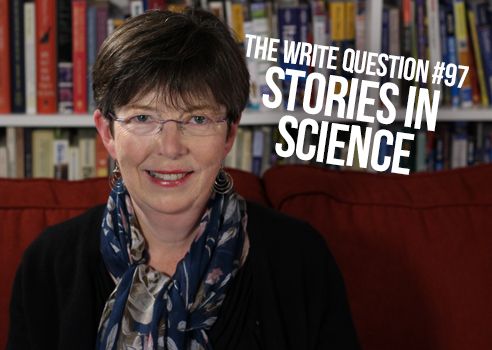Viewing time: 5 mins. 48 secs.
The Write Question is a weekly video podcast about writing that I started in 2017 and that ran, more or less weekly, until April 2022. This is a republication of issue #97, which addresses how to tell stories in science writing. The post first ran on June 28/19.
Transcript:
Welcome to The Write Question, I’m Daphne Gray-Grant and my topic today is how to tell stories in science.
I have an question from Tianying Wang — a post doctoral research scientist based at the Mailman School of Public Health at Columbia University in New York. Here’s what she’s asked:
“While reading your book — 8 ½ Steps to Writing Faster, Better — I have a question about Step 4, especially about how to use imaginary or true story as a lede. I found it is hard to implement it in scientific writing, such as papers on Nature and Science. Could you help illustrate how it works in scientific writing?”
Thanks for your question, Tianying. I know there is a widely held belief that stories don’t belong in articles based on science. As a result, not many researchers use them in their writing. But they could and they should.
To me, there are two great examples of scientific writers who excelled at story telling:
Lewis Thomas (1913 to 1993) is one. He spent his formative years as an independent medical researcher at the Tulane University School of Medicine. If you haven’t read any of his books, I can highly recommend The Lives of a Cell and Late Night Thoughts on Listening to Mahler’s Ninth Symphony. Links below. Both are superbly written and the first won two national book awards.
Let me read to you the first paragraph from The Lives of a Cell:
We are told that the trouble with Modern Man is that he has been trying to detach himself from nature. He sits in the topmost tiers of polymer, glass, and steel, dangling his pulsing legs, surveying at a distance the writhing life of the planet. In this scenario, Man comes on as a stupendous lethal force, and the earth is pictured as something delicate, like rising bubbles at the surface of a country pond, or flights of fragile birds. But is illusion to think that there is anything fragile about the life of the earth; surely this is the toughest membrane imaginable in the universe, opaque to probability, impermeable to death. We are the delicate part, transient and vulnerable as cilia.
Isn’t that beautiful?
The second remarkable writer I want to mention is Oliver Sacks (1933 to 2015). Like Thomas, he was well known for his wide-ranging interests and his ability to make writing both colourful and personal. You have probably already read his 1973 book Awakenings, link below.
Now, I know you’re going to say that books are different from peer-reviewed articles and, of course, you’re right. But the lessons you can learn from books may be applied to articles!
Here is a simple and very basic example from the May 13, 2019 issue of the Canadian Medical Association Journal:
“A previously healthy girl aged 10 years presented to the pediatric dermatology clinic with a 1-week history of an itchy eruption on the hands bilaterally. She had a similar eruption 6 months earlier after playing with homemade “slime” made with sodium borate (borax). On the day of the eruption, she was playing with slime that she had received from a friend.”
Apart from the word “slime” — which is fantastic — I think the writers could have made this a whole lot more interesting if they had jazzed up the writing a little bit. But they did take the first step by starting with a story…
Here is another example from a 2015 article in the Journal of Autism and Developmental Disorders:
“Public debates about autism policy are hardly unique to Canada. But they have been particularly acrimonious here—encompassing over a decade of conflict between parents of children with autism and policymakers, starting in the late 1990s.”
Again, I could quibble with the authors and suggest they could have pursued a slightly more assertive story-telling agenda. But notice how they have at least tried to dip their toes in a story-telling style.
Overall, any way in which you can tell a story at the beginning of the article is going to make that article far more interesting to readers. Think about the people you are studying. Further, consider all the non-human characters such as theories and ideas. What are their strengths, flaws and motivations? What are the obstacles they face?
Finally, let me wrap up with a quote from noted academic writer Helen Sword, author of Stylish Academic Writing, link below. “The art of academic storytelling is a complex business, yet it depends on a very simple principle: A good story makes people want to keep reading.”
Tianying, there’s no question that many academics shy away from story telling. This isn’t because story-telling is bad or wrong. It’s because other people don’t do it. Data always need to be presented in a way that is both objective and informative. But your readers are helped if you can present it in a way that offers an engaging narrative.
Links
The Lives of a Cell: Notes of a Biology Watcher by Lewis Thomas
Late Night Thoughts on Listening to Mahler’s Ninth Symphony by Lewis Thomas
Awakenings by Oliver Sacks
Stylish Academic Writing by Helen Sword


